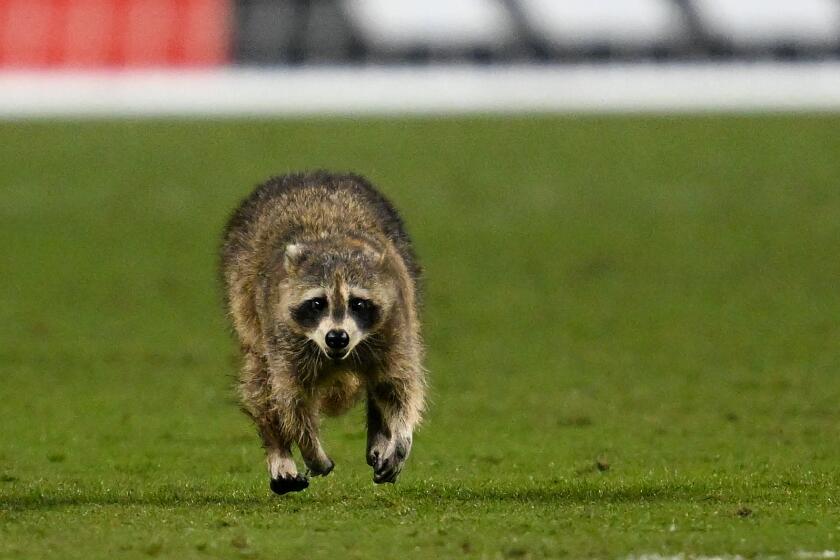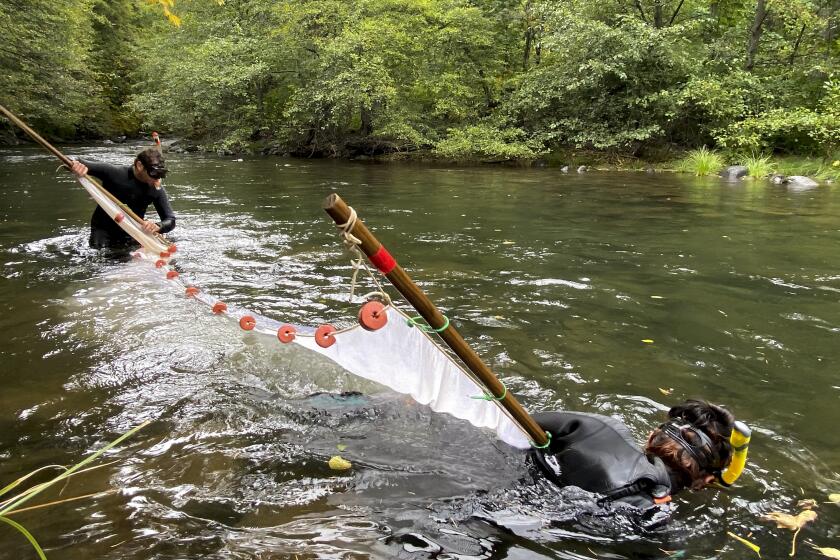Menagerie Nurtured at Pennsylvania Fairground : Retiree Is Friend to Variety of Castoff Animals
Radcliffe Smith’s large, weathered hands probe for burrs in the tangled fur of the Airedale sprawled at his feet, while several tail-wagging dogs pace excitedly around him.
He calls them by their new names--Bear, Tippy, Roy Rogers, Bea--and gives each of these canine castoffs a pat on the head and a smile.
Twice a day for more than 25 years, the 68-year-old former coal miner has been going to the Greene County fairgrounds to feed and care for animals he has found abandoned there.
In that time, Smith has cared for everything from owls to sheep and from cattle to mules. He is feeding a horse, seven dogs and several dozen cats, all at his own expense.
“I always said if I ever hit the lotto, I’d really take care of them,” he says with the drawl of the country folk in southwestern Pennsylvania.
No County Shelter
Because the rural county has no animal shelter, Smith has to draw the line when it comes to taking in pets that people simply grow tired of. Shelters in neighboring counties take in thousands of unwanted pets each year, and he simply does not have the room or money to provide for that many.
Rather, he is the last resort for the hard-core cases, for the cats hit on nearby highways, dogs caught in traps or starving farm animals left after a county fair.
“I’m always on the lookout for animals, not just any animal, but an animal that is in need,” Smith says.
“I’ve found many dogs and cats that have been hit by cars and dropped off here to die, and others half-starved and frozen. People have offered to pay me to take their dog, but I can’t do that. There are too many and I don’t have pens for them.”
A 1984 survey by the Washington-based Humane Society of the United States said more than 11.6 million dogs and cats are given to shelters annually, 7.6 million of which are put to sleep.
‘Slaughterhouse’
“Sometimes we just turn into a slaughterhouse,” says Bill Renn, director of the Allegheny County Humane Society in Pittsburgh, about 50 miles north.
Smith began his daily treks to the fairgrounds long before he left the mines with a back injury in 1968. When he was working, he would go before and after work and would stay longer if working nights.
Now he stays about six hours, taking long walks with the dogs to nearby Ten Mile Creek, grooming and feeding a neglected horse and snooping around the grounds for more forgotten animals.
“I always check around the stalls,” he says, nodding to rows of white clapboard buildings. “A while back one of them was boarded up. I bet it was close to two weeks. I decided to climb over that board fence and see what was going on.
“Well, I found a ton of sheep in there, without any water or any feed. There were a few lying there dead. The guy who was to pick up the sheep missed a whole pen of them. It was just an oversight.”
Horses Boarded
Smith cannot keep the animals at home because he lives in a trailer court where pets are forbidden. Officials at the fairgrounds, where Standardbred horses are boarded and trained for harness racing, have allowed him to use a small shed and fenced-in pen for the dogs.
As a result, Smith does not advertise his “shelter.” Although his heart is big, his resources are small and he does not want to test the patience of the fairgrounds’ staff or paying customers.
“I try to do the best I can, but there’s a race track here and they’ve got some pretty good horses on that track,” he says. “One of these 15-cent dogs may run out there and make a $30,000 horse fall down and break his leg, and they’d crucify me.”
Smith pays for feed, veterinary bills and miscellaneous expenses from his own pocket, but he refuses to estimate how much money he has spent on other people’s animals. He does not begrudge the money, but he gets upset with people, including the owner of a horse stabled at the fairgrounds, who starve their animals.
‘Skin and Bones’
The mare has not been out of her stall in two years, because the owner never comes to get her and there is no place to turn her out unsupervised. Nevertheless, Smith makes sure that she has enough to eat and that her quarters are kept clean.
“You should have seen the horse before I started feeding her,” he says. “Just awful. All skin and bones. It was real sad. I couldn’t stand it.
“One guy had an old thoroughbred in the barn once. It was eating its own manure. I got hay for it and raised enough hell that he took it out. That was my first experience with animal cruelty. That started me out.”
The thanks are few, Smith says, because people who abandon animals do not have much appreciation for those who take care of them.
“I once found a pair of mules starving to death,” he says, his face growing red. “I started to feed them for a few days while I was looking for the owner. I finally found him, and he said, ‘Heck, Smitty, I’m going to take them to the killers anyhow.’
More to Read
Start your day right
Sign up for Essential California for news, features and recommendations from the L.A. Times and beyond in your inbox six days a week.
You may occasionally receive promotional content from the Los Angeles Times.






